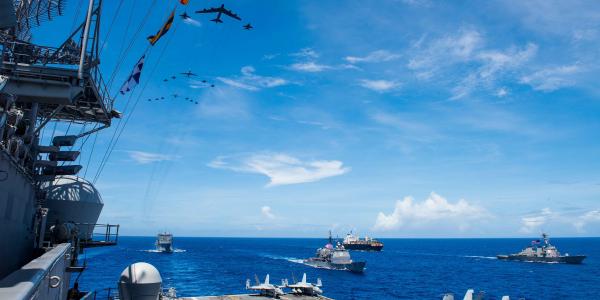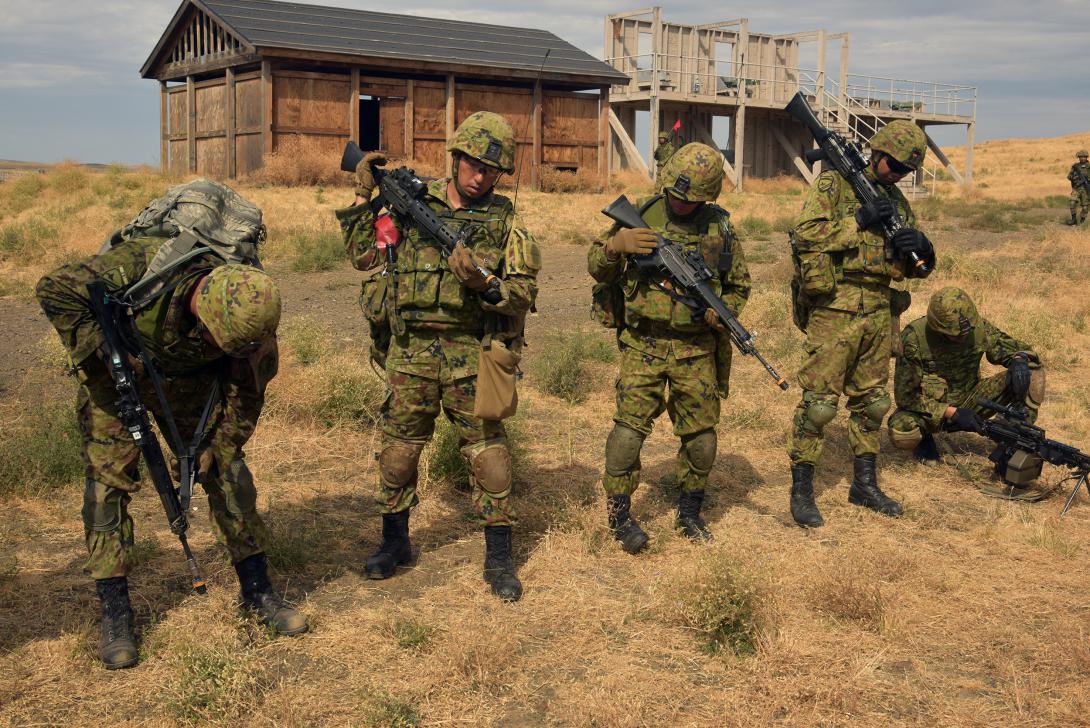U.S. Indo-Pacific Command Confronts Growing Regional Dynamism
More crisis points are challenging U.S. goals in the Indo-Pacific region, and the combined command in charge of that vast theater is gathering resources and partners to maintain an effective military and diplomatic presence against rivals and other threats to peace and security. The U.S. Indo-Pacific Command (INDOPACOM) is building new coalitions, acquiring innovative technologies and adding greater capabilities while continuing to carry out its mission.
More adversaries have risen to challenge the U.S. presence in the Indo-Pacific region, and they are wielding more advanced capabilities. But concurrently, more nations are looking toward the U.S. vision to regional security and prosperity and are reaching out to be part of INDOPACOM’s efforts at maintaining stability.
The command is pursuing a competitive strategy that aims at deterrence, says its commander, Adm. Phil Davidson, USN. He describes the strategy’s goal as knitting together allies and partners to assure them of the way ahead, thereby deterring adversaries in the region.
“There has been a general convergence around the idea of a free and open Indo-Pacific,” the admiral states. “Since the president announced that vision in the fall of 2017 in Vietnam, you’ve seen a number of other nations articulate very similar visions or strategies.” He cites Japan, Australia, New Zealand and India as among the nations expressing the same goals for the vast region, adding that the Association of Southeast Asian Nations (ASEAN) has offered the same inclusive ideal. “It’s making the conversation on what the way ahead is much easier here with our allies and partners in the region,” he says.
The United States has undergone an erosion of its joint advantages in the vast theater, and this is the biggest challenge facing INDOPACOM, Adm. Davidson offers. China has increased both the quality and quantity of its forces, including all new capabilities such as stealth aircraft and more sophisticated offensive fires. Countering this Chinese surge will require extensive work to understand China’s force trajectory as well as to regain the U.S. advantage over the People’s Liberation Army.
In addition to eroding U.S. advantages in the Indo-Pacific region, China is striving to increase its influence elsewhere in the globe. The United States needs to advance some of its own capabilities to meet the Chinese challenge, he continues. “We have a ways to go still, and we’re not there yet,” the admiral declares.
China has started to test and develop hypersonic weapons, among others. These types of systems are not undefeatable, Adm. Davidson points out, but working with the Defense Department and Congress is at the heart of the command’s efforts to counter the Chinese technological rise. “Getting after the capability set is going to be important,” he states. “We have to invest heavily in offensive fires—long-range precision fires, offensive hypersonics. We need to continue to work on integrated air and missile defense, and that has to include defenses against hypersonics—we have to think about the next iteration of those capabilities,” he says. Directed energy weapons could play a significant role in defenses against the burgeoning threat environment.
A related area for improvement is the integration of fires. And, assuredness must see progress—assured access to space, to networks and to precision navigation and timing. All these activities are critical, the admiral declares.
“There are advances required from the bottom of the sea to the outer limits of space that are all on the docket,” he says.
“It is no secret that I’ve said China is the greatest long-term strategic threat to the region,” the admiral states. “You’re seeing it play out in all aspects of diplomacy, the information environment, their military capitalization, pernicious economics, using fear and coercion—working to expand their branch of communist ideology in order to bend, break and ultimately supplant the international-based order with one of their own making. You’ve heard them quite frequently speaking about having an international order with Chinese characteristics,” he observes.
As SIGNAL went to press, the civil unrest in Hong Kong continued to build. Adm. Davidson allows that INDOPACOM has been monitoring the situation there, and the U.S. government has urged all sides to exercise restraint and refrain from violence. “It’s a core value in the United States that we encourage peaceful assembly and freedom of expression, and that must be vigorously protected,” he states.
“Hong Kong is quite the international city when you start to rack up the number of foreign citizens that actually reside and work there; you’d have to say that the whole world is watching this very closely,” he continues. “That goes without saying here in the headquarters.” He emphasizes that INDOPACOM does not have a direct military role, but the command is observing the situation closely.
Russia is a continuing problem, as Adm. Davidson cites “their growing maligned influence across the globe and throughout the region.” He notes that Russia is acting as an obstructionist to U.S. efforts wherever it can. “They’ve regularly played the role of spoiler seeking to undermine U.S. interests and hoping to impose additional costs on the United States and our allies in the region, whenever they get the opportunity,” he points out.
The Korean Peninsula represents another challenge. “Until the nuclear situation is resolved, North Korea will remain our most immediate threat,” he declares.
Away from nation-states, terrorism remains a concern. Terror groups continue to strive to impose their views and radicalize people across the Indo-Pacific region, which was demonstrated when ISIS captured and devastated the Philippine city of Marawi in 2017. “That’s no village; Marawi was a city of 200,000 people,” he relates, adding he was impressed with the way Philippine armed forces and national police force met the threat and drove out ISIS. “We have to continue to stay engaged with the terrorist threat out here,” he posited.
Geopolitically, India represents “a key strategic opportunity for the nation going forward,” Adm. Davidson says. The Asian country’s designation as a major defense partner in 2016 reflects its importance to the United States, he adds. Several long-term activities bode well for progress in the two nations’ rapport and for broadening the basis for their military relationships. In addition to more maritime activities, this progress entails strengthening intelligence and information sharing. The bulk of this sharing involves combatting terrorism, the admiral reports, but other opportunities include maritime domain awareness. The United States also has been providing counterterrorism training for several years.
Last year, the two nations signed the Communications Compatibility and Security Agreement (COMCASA) to help link similar communications systems and improve interoperability. It will enable linkage between maritime headquarters, for example. The admiral describes this as a key opportunity for future development in the relationship.
But while India’s relationship with the United States grows closer, two other longtime U.S. allies in the region have hit rough waters in their own relations. Disputes between Japan and South Korea have had ramifications in their security relationship. Adm. Davidson relates that officials in every level of the U.S. government have expressed “concern and disappointment” over South Korea’s decision not to renew the General Security of Military Information Agreement (GSOMIA) between the two countries. This agreement was valuable amid the growing uncertainty generated by North Korea and the long-term challenge by China, as it unlocked a valuable level of direct bilateral information sharing between South Korea and Japan.
U.S. cooperation with the two conflicted allies is still strong, Adm. Davidson reports. All three nations have joined with others to enforce U.N. sanctions against refined petroleum deliveries to North Korea, and that cooperation continues at the operational level in the East China Sea and the Yellow Sea. Trilateral ballistic missile defense exercises will continue, he adds, with an existing trilateral information sharing agreement helping fill in some of the gaps from losing GSOMIA. Adm. Davidson has engaged his counterparts in the two nations in the hope that they can resolve their dispute before the GSOMIA formally is suspended this month.
INDOPACOM works with many nations in disaster management, as the region is host to frequent cyclonic storms, earthquakes, volcanoes and occasional tsunamis. Adm. Davidson notes that the command has its own Center for Excellence in Disaster Management and Humanitarian Assistance in Joint Base Pearl Harbor–Hickam, Hawaii. The center trains uniformed, governmental and nongovernmental organizations from around the world in necessary skills.






Comments